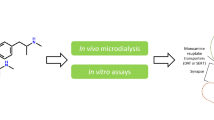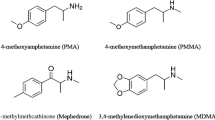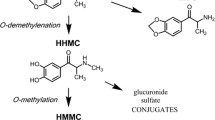Abstract
New psychoactive drugs (NPDs), or so-called “designer drugs” are chemically transformed compounds of traditional drugs of abuse for the purpose of evading crackdown. The abuse of NPDs is a significant social problem and threatens public health; however, few studies on their effects on the central nervous system have been conducted. Microdialysis is a useful in vivo sampling technique in neurochemistry because it enables monitoring of synaptic release of neurotransmitters by drug exposure or other stimuli in real time. Dopamine (DA) and serotonin (5-HT) are important neurotransmitters associated with drug abuse and addiction. In this study, changes of DA, 5-HT and their metabolites in brain microdialysates from rats following exposure to selected 11 NPDs (MPA, 5-APDB, PCA, α-PVT, AB-PINACA, QUPIC, 5-fluoropentyl-3-pyridinoylindole, AMT, NMT, 4-OH-DET and desoxy-D2PM, 0.3, 1 and 3 mg/kg, consecutively, intraperitoneally) were investigated using a validated liquid chromatography –tandem mass spectrometry method. Most NPDs affected the extracellular levels of DA, 5-HT and/or their metabolites, showing consistent changes depending on the groups of chemical structures, such as amphetamines, synthetic cannabinoids and tryptamines. Significant DA and/or 5-HT increases were observed for all the amphetamine analogues. Weak fluctuations of DA and/or 5-HT concentrations were observed following exposure to synthetic cannabinoids and more severe fluctuations were shown by the tryptamines. The current results could be used as the preliminary data for further research concerning monoamine neurotransmitter-related mechanisms of NPDs. Moreover, the understanding gained from this research could be helpful to monitor the liability of NPD abuse and addiction.




Similar content being viewed by others
References
Liechti M (2015) Novel psychoactive substances (designer drugs): overview and pharmacology of modulators of monoamine signaling. Swiss Med Wkly 145:w14043
Zawilska JB, Andrzejczak D (2015) Next generation of novel psychoactive substances on the Horizon–a complex problem to face. Drug Alcohol Depend 157:1–17
Anderzhanova E, Wotjak CT (2013) Brain microdialysis and its applications in experimental neurochemistry. Cell Tissue Res 354:27–39
Boschi G, Scherrmann J (2000) Microdialysis in mice for drug delivery research. Adv Drug Deliv Rev 45:271–281
Plock N, Kloft C (2005) Microdialysis—theoretical background and recent implementation in applied life-sciences. Eur J Pharm Sci 25:1–24
Darvesh AS, Carroll RT, Geldenhuys WJ, Gudelsky GA, Klein J, Meshul CK, Van der Schyf CJ (2011) In vivo brain microdialysis: advances in neuropsychopharmacology and drug discovery. Expert Opin Drug Discov 6:109–127
Chaurasia CS, Chen CE, Ashby CR Jr (1999) In vivo on-line HPLC-microdialysis: simultaneous detection of monoamines and their metabolites in awake freely-moving rats. J Pharm Biomed Anal 19:413–422
Nirogi R, Komarneni P, Kandikere V, Boggavarapu R, Bhyrapuneni G, Benade V, Gorentla S (2013) A sensitive and selective quantification of catecholamine neurotransmitters in rat microdialysates by pre-column dansyl chloride derivatization using liquid chromatography-tandem mass spectrometry. J Chromatogr B 913-914:41–47
Greco S, Danysz W, Zivkovic A, Gross R, Stark H (2013) Microdialysate analysis of monoamine neurotransmitters—a versatile and sensitive LC–MS/MS method. Anal Chim Acta 771:65–72
Cannazza G, Carrozzo MM, Cazzato AS, Bretis IM, Troisi L, Parenti C, Braghiroli D, Guiducci S, Zoli M (2012) Simultaneous measurement of adenosine, dopamine, acetylcholine and 5-hydroxytryptamine in cerebral mice microdialysis samples by LC–ESI-MS/MS. J Pharm Biomed Anal 71:183–186
Parrot S, Neuzeret PC, Denoroy L (2011) A rapid and sensitive method for the analysis of brain monoamine neurotransmitters using ultra-fast liquid chromatography coupled to electrochemical detection. J Chromatogr B 879:3871–3878
Yoshitake T, Kehr J, Yoshitake S, Fujino K, Nohta H, Yamaguchi M (2004) Determination of serotonin, noradrenaline, dopamine and their metabolites in rat brain extracts and microdialysis samples by column liquid chromatography with fluorescence detection following derivatization with benzylamine and 1,2-diphenylethylenediamine. J Chromatogr B 807:177–183
Gingrich JA, Hen R (2001) Dissecting the role of the serotonin system in neuropsychiatric disorders using knockout mice. Psychopharmacology 155:1–10
Hirao K, Pontone GM, Smith GS (2015) Molecular imaging of neuropsychiatric symptoms in Alzheimer’s and Parkinson’s disease. Neurosci Biobehav Rev 49:157–170
Iversen L, White M, Treble R (2014) Designer psychostimulants: pharmacology and differences. Neuropharmacology 87:59–65
Matsumoto T, Maeno Y, Kato H, Seko-Nakamura Y, Monma-Ohtaki J, Ishiba A, Nagao M, Aoki Y (2014) 5-Hydroxytryptamine- and dopamine-releasing effects of ring-substituted amphetamines on rat brain: a comparative study using in vivo microdialysis. Eur Neuropsychopharmacol 24:1362–1370
Kehr J, Ichinose F, Yoshitake S, Goiny M, Sievertsson T, Nyberg F, Yoshitake T (2011) Mephedrone, compared with MDMA (ecstasy) and amphetamine, rapidly increases both dopamine and 5-HT levels in nucleus accumbens of awake rats. Br J Pharmacol 164:1949–1958
Kim M, Lee JG, Yang CH, Lee S (2016) Silica stationary phase-based on-line sample enrichment coupled with LC–MS/MS for the quantification of dopamine, serotonin and their metabolites in rat brain microdialysates. Anal Chim Acta 923:55–65
Zhao RJ, Yoon SS, Lee BH, Kwon YK, Kim KJ, Shim I, Choi KH, Kim MR, Golden GT, Yang CH (2006) Acupuncture normalizes the release of accumbal dopamine during the withdrawal period and after the ethanol challenge in chronic ethanol-treated rats. Neurosci Lett 395:28–32
Zaitsu K, Hayashi Y, Kusano M, Tsuchihashi H, Ishii A (2016) Application of metabolomics to toxicology of drugs of abuse: a mini review of metabolomics approach to acute and chronic toxicity studies. Drug Metab Pharmacokinet 31:21–26
Welter-Luedeke J, Maurer HH (2016) New psychoactive substances: chemistry, pharmacology, metabolism, and detectability of amphetamine derivatives with modified ring systems. Ther Drug Monit 38:4–11
Kaizaki A, Tanaka S, Numazawa S (2014) New recreational drug 1-phenyl-2-(1-pyrrolidinyl)-1-pentanone (alpha-PVP) activates central nervous system via dopaminergic neuron. J Toxicol Sci 39:1–6
Marusich JA, Antonazzo KR, Wiley JL, Blough BE, Partilla JS, Baumann MH (2014) Pharmacology of novel synthetic stimulants structurally related to the "bath salts" constituent 3,4-methylenedioxypyrovalerone (MDPV). Neuropharmacology 87:206–213
Kolanos R, Sakloth F, Jain AD, Partilla JS, Baumann MH, Glennon RA (2015) Structural modification of the designer stimulant α-pyrrolidinovalerophenone (α-PVP) influences potency at dopamine transporters. ACS Chem Neurosci 6:1726–1731
Monte AP, Marona-Lewicka D, Cozzi NV, Nichols DE (1993) Synthesis and pharmacological examination of benzofuran, indan, and tetralin analogues of 3,4-(methylenedioxy)amphetamine. J Med Chem 36:3700–3706
Rickli A, Kopf S, Hoener MC, Liechti ME (2015) Pharmacological profile of novel psychoactive benzofurans. Br J Pharmacol 172:3412–3425
Iversen L, Gibbons S, Treble R, Setola V, Huang XP, Roth BL (2013) Neurochemical profiles of some novel psychoactive substances. Eur J Pharmacol 700:147–151
Johnson MP, Huang XM, Oberlender R, Nash JF, Nichols DE (1990) Behavioral, biochemical and neurotoxicological actions of the α-ethyl homologue of p-chloroamphetamine. Eur J Pharmacol 191:1–10
Lanteri C, Salomon L, Torrens Y, Glowinski J, Tassin JP (2008) Drugs of abuse specifically sensitize noradrenergic and serotonergic neurons via a non-dopaminergic mechanism. Neuropsychopharmacology 33:1724–1734
Saadat KS, Elliott JM, Colado MI, Green AR (2006) The acute and long-term neurotoxic effects of MDMA on marble burying behaviour in mice. J Psychopharmacol 20:264–271
Murnane KS, Perrine SA, Finton BJ, Galloway MP, Howell LL, Fantegrossi WE (2012) Effects of exposure to amphetamine derivatives on passive avoidance performance and the central levels of monoamines and their metabolites in mice: correlations between behavior and neurochemistry. Psychopharmacology 220:495–508
De Luca MA, Bimpisidis Z, Melis M, Marti M, Caboni P, Valentini V, Margiani G, Pintori N, Polis I, Marsicano G, Parsons LH, Di Chiara G (2015) Stimulation of in vivo dopamine transmission and intravenous self-administration in rats and mice by JWH-018, a Spice cannabinoid. Neuropharmacology 99:705–714
Ossato A, Canazza I, Trapella C, Vincenzi F, De Luca MA, Rimondo C, Varani K, Borea PA, Serpelloni G, Marti M (2016) Effect of JWH-250, JWH-073 and their interaction on "tetrad", sensorimotor, neurological and neurochemical responses in mice. Prog Neuropsychopharmacol Biol Psychiatry 67:31–50
De Luca MA, Castelli MP, Loi B, Porcu A, Martorelli M, Miliano C, Kellett K, Davidson C, Stair JL, Schifano F, Di Chiara G (2015) Native CB1 receptor affinity, intrinsic activity and accumbens shell dopamine stimulant properties of third generation SPICE/K2 cannabinoids: BB-22, 5F-PB-22, 5F-AKB-48 and STS-135. Neuropharmacology 105:630–638
Blough BE, Landavazo A, Decker AM, Partilla JS, Baumann MH, Rothman RB (2014) Interaction of psychoactive tryptamines with biogenic amine transporters and serotonin receptor subtypes. Psychopharmacology 231:4135–4144
Nagai F, Nonaka R, Satoh K, Kamimura H (2007) The effects of non-medically used psychoactive drugs on monoamine neurotransmission in rat brain. Eur J Pharmacol 559:132–137
Arunotayanun W, Dalley JW, Huang XP, Setola V, Treble R, Iversen L, Roth BL, Gibbons S (2013) An analysis of the synthetic tryptamines AMT and 5-MeO-DALT: emerging novel psychoactive drugs. Bioorg Med Chem Lett 23:3411–3415
Sakashita Y, Abe K, Katagiri N, Kambe T, Saitoh T, Utsunomiya I, Horiguchi Y, Taguchi K (2015) Effect of psilocin on extracellular dopamine and serotonin levels in the mesoaccumbens and mesocortical pathway in awake rats. Biol Pharm Bull 38:134–138
Simmler LD, Rickli A, Schramm Y, Hoener MC, Liechti ME (2014) Pharmacological profiles of aminoindanes, piperazines, and pipradrol derivatives. Biochem Pharmacol 88:237–244
Davidson C, Ramsey J (2012) Desoxypipradrol is more potent than cocaine on evoked dopamine efflux in the nucleus accumbens. J Psychopharmacol 26:1036–1041
Acknowledgments
This research was supported by a grant from the Ministry of Food and Drug Safety (14182MFDS979) and by the Basic Science Research Program through the National Research Foundation of Korea (NRF) funded by the Ministry of Science, ICT & Future Planning (NRF-2014R1A1A1036222).
Author information
Authors and Affiliations
Corresponding author
Ethics declarations
Conflict of interest
The authors declare that they have no conflicts of interest.
Ethical approval
This article does not contain any studies with human participants performed by any of the authors. All experiments were carried out in accordance with the guidelines of the Institutional Animal Care and Use Committee at Daegu Haany University.
Rights and permissions
About this article
Cite this article
Kim, M., Kim, D.H., Lee, Y.S. et al. Changes in dopamine, serotonin and their metabolites in brain microdialysates from rats following exposure to new psychoactive drugs. Forensic Toxicol 35, 66–76 (2017). https://doi.org/10.1007/s11419-016-0335-8
Received:
Accepted:
Published:
Issue Date:
DOI: https://doi.org/10.1007/s11419-016-0335-8




